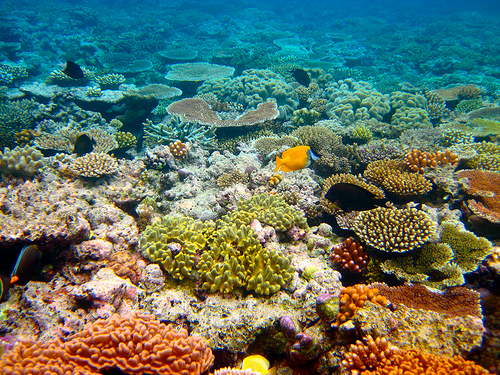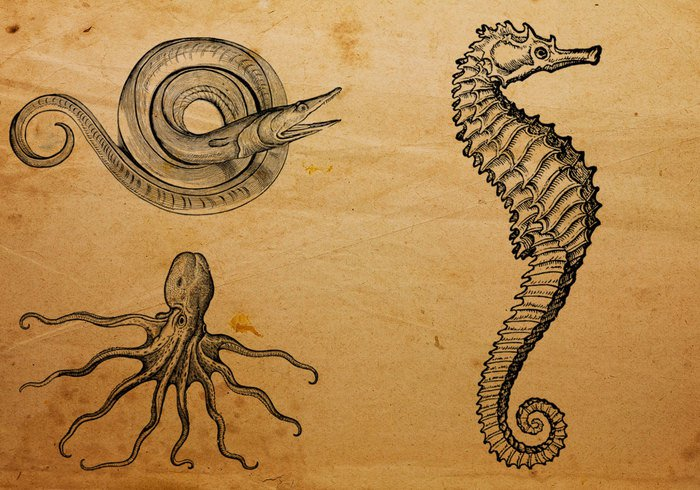Medicine from the sea
During the past decades marine biotechnology has been applied to the areas of public health and human disease, seafood safety, development of new materials and processes. The prospect of finding a new drug in the sea, especially among coral reef species, may be 300 to 400 times more likely than isolating one from a terrestrial ecosystem. Although terrestrial organisms exhibit great species diversity, marine organisms have greater phylogenetic diversity, including several phyla and thousands of species found nowhere else.
Coral reefs are home to many species and are probably the most diverse habitats on Earth. Corals are the "bioengineers" of these systems, providing the habitat to algae, fish, crustaceans or sponges. The species exist simultaneously in various forms of symbiosis, and constant turf war too [1].

Marine and reef life organisms must compete for available food. They have to employ offensive and defensive weapons. They also need the ability to sustain damage, heal wounds and still continue to reproduce. That is where secondary metabolites crafted by evolutionary struggle come to help.
For example, a cone snail living in coral reefs and preying on small fish, produces venom that naturally causes paralysis in its victims. Such secondary metabolites became topics of great scientific interest, and are utilised in cytotoxic compounds research, testing and production. The deadly snail's venom is structurally related to new drugs that block the nerves in the spinal cord that send pain signals to the brain, functioning as a new class of effective pain killers.
Corals and sponges provide another example. In the wild, coral reefs are in a constant slow motion and often invisible territorial war. They expel digestive filaments which contain cnidocytes (digestive fluids), and "sniff" the water for invaders. After contact, they continue to discharge nematocysts: specialized cells containing a barbed or venomous threat, that damage the invader. They produce mucus that can be "sticky" and carry toxic secondary metabolites to long distances in the water current. Such "war" tactics of chemical competition can be quite effective. The production of toxic compounds is known as allelopathy. Toxins emitted by these corals can be lethal to fish, effective in the aggressive competition for space on the reef and provide excellent defense against predation and parasitism [2].
Sponges are one of the oldest groups of animals existing on Earth. They evolved about 650 million years ago, well before the invention of paws, antennae or wings. Nowadays, they are extremely common and diverse, especially in coral reefs where sponge diversity can be anywhere between 200 to 600 species. Sponges are generally benign. They co-exist with corals on reefs and themselves provide homes for small animals and plants, and help support the reef by cementing corals and rubble. But some species, dubbed the excavating sponges, erode the matrix of the coral for a living and may cause actual damage to the reef structure. For example, sponge Cryptothetya crypta DNA containes unusual nucleosides that inhibit the replication of foreign genetic material.
Among the earliest modern medicines obtained from coral reefs are the antiviral drugs Ara-A and AZT, and the anticancer agent Ara-C, developed from extracts of sponges found on a Caribbean reef. The first marine-derived drug approved for use by the Food and Drug Administration (FDA) was Ara-C, or Cytarabine. Cytarabine owes its discovery to a Caribbean sponge's ability to inhibit the replication of foreign genetic material. Researchers realized that this characteristic could be used to prevent tumor cells from dividing and replicating, and therefore used the sponge nucleosides to create a cytostatic drug that was the basis for the synthesis of Cytarabine.
Other products, such as Dolostatin 10, isolated from a sea hare found in the Indian Ocean, are under clinical trials for use in the treatment of breast and liver cancers, tumors, and leukemia. Bryozoan Bugula neritina, a common fouling organism (similar to barnacles) that is found in both temperate and tropical climates, is a source for the anti-cancer compound bryostatin. Blue-green algae, commonly found in Caribbean mangroves, are used to treat small-cell lung cancer. The National Cancer Institute also endorsed blue-green algae for the treatment of melanoma and some tumors.
During the course of investigations on bioactive natural products from marine organisms, the extracts of marine fungus isolated from South China Sea soft coral gorgonian and identified as Aspergillus sp., exhibited definite brine shrimp cytotoxicity. Further bioassay-guided studies led to the obtainment of mycotoxins: aspergillic acid (BMRB entry bmse001279) derivatives and metal complexes. They demonstrated remarkable anti-microbial and cytotoxic activities in studies of effective anti- deadly "hospital bug" and anticancer drugs [3].
Secosteroids, an enzyme used by corals to protect themselves from disease, is used to treat asthma, arthritis and other inflammatory disorders. Researchers are studying bivalves, a class of mollusks, to learn more about aging processes, including metabolic activity and environmental stressors. In relation to that, the potential of marine mollusks as a source of rare polyunsaturated fatty acids (PUFA) is also being investigated, particularly of arachidonic and eicosapentaenoic acids.

Other fascinating marine organisms: sea cucumbers, have long time been recognized as having an impressive range of folk medicine applications in various Asian cultures. In addition to having a high nutritious value, they "nourish the body, tonify kidney, moisten dryness of the intestines", treat stomach ulcers, asthma, hypertension, rheumatism and heal wounds. Fatty acids of sea cucumber lipids fractions are the key components responsible for tissue repair and wound healing properties of this marine animal. Fatty acid profile of the lipid fractions contains myristic, palmitic, stearic, linoleic, arachidic, eicosapentaenoic and docosahexaenoic acid. Presence of considerable amount of eicosapentaenoic acid (EPA) and decosahexaenoic acid (DHA) in several species, especially in tropical and abyssal sea cucumbers, is medicinally important as these two long-chain fatty acids are associated with the reduced incidence of coronary heart diseases and certain cancers.
Symbioses between microorganisms and marine organisms are abundant and widespread in the sea. Most marine invertebrates and algae harbor diverse microbial symbionts including prokaryotic bacteria, archaea, cyanobacteria, and fungi. Increasing evidence points to the microbial symbionts as the true source of compounds of interest, which makes them a hot topic of marine microbiology and marine natural products biotechnology.
For example, the Actinobacteria isolated from sponge C. austrialiensis proved to have a broad-spectrum of antimicrobial activity, and antimicrobial screening showed that multiple strains inhibited the growth of terrestrial microorganisms. These pharmaceutically active secondary metabolites from actinomycete, with main skeleton of 1-acetyl-beta-carboline, show anti-MRSA action. MRSA stands for methicillin-resistant Staphylococcus aureus: one of the "hospital superbugs".
Regarding the structural types, incredibly diverse compounds from marine‐derived sources also include numerous alkaloids, polyketides, peptides, terpenes, lactones, and steroids. Biological activities of new compounds from marine‐derived fungi are mainly focused in the areas of cytotoxicity and antimicrobial activity, including antibacterial activity, antifungal, antioxidant activity and antiviral activity. Furthermore, other possible applications include anti-inflammatory, antifouling, lipid-lowering functions.
With continued exploration and development of SCUBA, new groups of organisms are being investigated. There is a rich pipeline of clinical and pre-clinical marine source compounds to suggest their continued application in human medicine. Understanding of how these agents are biosynthetically assembled has accelerated in recent years, especially through interdisciplinary approaches and re-engineering of some of standard analytical techniques enhanced by the development of new bioinformatics tools.
There are two historical approaches to natural products discovery: "isolate and then test" versus "test and then isolate". Today, a combined tactic is usually employed, with extracts or fractions being tested for bioactive compounds, and bioassay-guided approaches used. Additionally, profiling of the material by NMR techniques and/or LC-MS for unique chemical constituents can be followed by their isolation and broad evaluation in diverse biological assays [4]. Here, Nuclear Magnetic Resonance (NMR) spectroscopy is increasingly used as a technique to provide insight into mixture of natural products belonging to the same or different chemical classes without previous separation of the individual components.
The metabolomics database at the BMRB contains 1H, 13C, 13CDEPT90, DEPT135, TOCSY, COSY45, HSQC, HMBC and HSQC-TOCSY-ADIA NMR data for various compounds related to current marine sources research. Time-domain data, spectra pictures, tables of peak transitions and assigned chemical shifts are also available, providing a solid ground and visual context for experimental strategies planning.
[1] A.W.Bruckner, Life-saving products from coral reefs, Issues in Science and Technology, vol.18(3), 35 (2002)
[2] S. Coello, Sponge competition may damage corals, Phys.org, May 3, 2011
[3] Zhiyong Li, Advances in Marine Microbial Symbionts in the China Sea and Related Pharmaceutical Metabolites Mar. Drugs 2009, 7(2), 113-129 (doi:10.3390/md7020113)
[4] Gerwick, W.H., Moore, B.S., Lessons from the past and charting the future of marine natural products drug discovery and chemical biology Chem. Biol. 2012, 19(1), 85–98. (doi: 10.1016/j.chembiol.2011.12.014)
